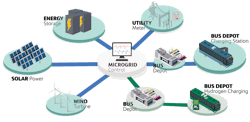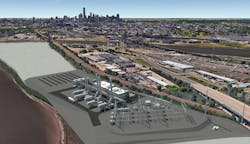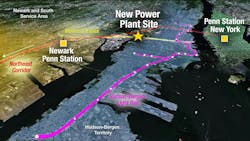Resilience is what makes microgrids attractive as back-up energy controls
By Roger Copeland, Principal, Jacobs
Over the last few years, weather has fluctuated erratically and impacted how industries, cities, healthcare facilities, universities and other mission critical organizations maintain operational readiness. As these entities, along with municipalities and cities, prioritize building resilience, microgrid solutions are gaining traction.
At their core, microgrids are analogous to back-up generators for a local power system. At a deeper level, a generator controller must balance the generation output to the load in real-time and serve as a balancing authority to control voltage and frequency, not unlike the larger grid operator.
These microgrids are typically operated in parallel with the local grid to provide additional supply surety, complicating the generation balancing approach. Microgrid owners possess the assets and must control the grid with technology, engineering, and operations to manage the generation and distribution in order to maintain the supply both with and without grid support.
MITIGATING ENVIRONMENTAL IMPACT
As the world transitions from carbon-intensive fossil resources to a greener electric grid, the shift to date has been led by solar and wind renewable resources. Unfortunately, these resources do not produce energy when called upon but rather when the wind blows or the sun shines.
Developing a microgrid solution with limited dispatchable resources requires careful attention to the potential energy available either in fuel resources (typically carbon-based) or in large scale stored energy that can be dispatched to respond to load needs in real-time. With the use of a storage-only solution, designs can be flexible and respond to load, but only allow a definite time of emergency response capacity without external grid support.
As such, resilient microgrids require a fossil-based anchor resource to ensure reliability. While fossil resources aren’t usually known for being environmentally sound, potential impacts can be optimized through thoughtful application of a combined heat and power system.
These systems are often found in locations where a predictable demand for heat energy coincides with electrical demands, such as higher education or healthcare campuses. Combined heat and power systems provide resilient, efficient thermal and electrical energy for campuses both during steady state and emergency conditions.
An additional approach being deployed to minimize the carbon impact of microgrids applies fossil-based flexible resources that are future-proofed to plan for deployment of hydrogen fuel in a traditional fossil resource. Many manufacturers are already developing these hydrogen-capable solutions, and as the hydrogen economy and infrastructure mature over the coming years, the solutions may be able to transition from fossil through a blend with hydrogen to eventually a pure hydrogen (zero carbon) application.
WITHSTANDING UNPREDICTABLE WEATHER
As with any power system, microgrid systems are vulnerable to extreme weather and climate events, and must be weatherized adequately and prepared for a full range of weather and system conditions.
For example, in early 2021, according to Johns Hopkins, the state of Texas faced its coldest winter weather in more than 70 years and simultaneously experienced statewide utilities failure. When temperatures in Texas dropped lower than temperatures in Alaska, more than 4.5 million homes and businesses lost their power and at least 70 people lost their lives.
The Electric Reliability Council of Texas (ERCOT) manages the flow of electric power to more than 26 million Texas customers—representing about 90 percent of the state’s electric load. As the independent system operator for the region, ERCOT schedules power on an electric grid that connects more than 46,500 miles of transmission lines and 710-plus generation units. The uncharacteristically Arctic temperatures exposed the weaknesses in an electricity system designed when the weather’s seasonal shifts were more consistent and predictable—conditions that most weather experts believe no longer exist. As a result, ERCOT relied on rolling blackouts.
Experts recommend rolling blackouts as a last resort when power demand overwhelms supply and threatens to create a wider collapse of the whole power system. Usually, utilities black out certain zones before cutting off power to another area. Luckily, hospitals, fire stations, water-treatment plants and other key facilities are typically spared. But as many Texans experienced, the blackouts can be devastating for residential neighborhoods during extreme weather.
UNIVERSITIES LEAD THE WAY
During the entire winter storm event, the microgrid deployed at the University of Texas at Austin was able to maintain electrical supply, heating, and even cooling for a 20-million-sf campus with buildings for research, housing, dining, and healthcare. This advanced microgrid is one of the most efficient in the world, having had only four outages in the last 54 years. The university’s ability to remain operational provided life-saving heat to students who live on campus, and minimized damage from frozen assets in buildings.
UT’s microgrid is currently fueled by natural gas. The University is integrating on-campus solar thermal and solar PV resources as well as investigating adapting these generation resources to blend and convert to hydrogen over time.
In New Jersey, Princeton University had a similar success story with its microgrid in the wake of Superstorm Sandy in 2012. The campus leveraged its microgrid to sustain operations through the unpredictable storm and provide safe refuge. Its system combined a heat and power system based on natural gas. The University is currently integrating renewable resources and optimizing the deployment of fossil assets to minimize the impact without sacrificing resilience that the system affords.
Both success stories stem from clients that were proactive in investing in resilient on-campus generation sources that were optimized to steady state operation but flexible enough to deploy without-grid connectivity. The heat and power solutions paid for themselves through their energy savings, and provided incalculable value from inherent resilience.
In 2020, net zero carbon commitments roughly doubled, with many countries embracing the opportunity to deliver “green stimulus” to support economic recovery from the COVID-19 pandemic. Microgrids can help deploy more zero-emissions energy sources, make use of waste heat, reduce energy lost through transmission lines, help manage power supply and demand and improve grid resilience to extreme weather.
Here are some tips for firms and their clients that are considering microgrids:
•Develop Transit Resilience
Dynamic and sometimes dangerous weather events are increasingly creating challenges to power grids and, consequently, to the populations served by them. Crippling events like Hurricane Irma, Superstorm Sandy and Winter Storm Uri highlight the importance of resilient power to keep transportation systems running during widespread disturbances. Microgrids can help keep transportation systems powered and moving, delivering not only first responders to an area, but also evacuating people from the affected region, particularly in areas that rely heavily on public transit.
•Plan for Decarbonizing Microgrids
Microgrids must be able to respond to massive dynamic loads, particularly for rail and mass transit. These dynamic loads put stress on generation systems that must operate without the utility grid. Carbon (and nuclear) sources are adept at responding to rapidly changing load profiles. However, with the increased push for decarbonization, these sources aren’t always viable solutions. Inverter-based generation lacks inertia, requiring separate energy storage to respond, whereby fossil resources have both dynamic inertia and can respond with greater or lesser fuel. It’s important to understand how taxing the load is on the microgrid to ensure that the proposed solution is flexible enough to adequately respond to the load dynamics.
•Microgrids and CHP Systems
Combined heat and power (CHP) can offer a cost-effective way to simultaneously produce power and heat, with the heat used for district heating (or cooling) applications and the electricity to be used on-site. To truly capitalize on the efficiencies of CHP, it should be applied in situations that have a direct need for heat (or cooling), and sufficient electrical load for the generation solution sized for the thermal load. For example, heating and powering a research campus such as UT Austin provides a steady thermal load with a deep electrical load. Through careful planning and thoughtful investment, the UT CHP microgrid is flexible enough to respond to changes in electrical and thermal loads independently while also boasting one of the most efficient CHP systems in the world.
•The Hydrogen Solution
Hydrogen infrastructure is in its infancy. Current large-scale hydrogen is produced by steam methane reforming, which is not a “green” process. Even though this is currently the most effective way to secure large-scale hydrogen, “grey” hydrogen still releases carbon into the atmosphere. Current research is pushing new technologies including pink hydrogen produced by high temperature electrolysis at nuclear generation facilities, various forms of storage in salt caverns or liquefication, advanced electrolyzers, fuel cells, solid state hydrogen fuel cells, and power-to-hydrogen-to-power applications.
Cost-competitiveness is also a consideration: for example, the U.S. Department of Energy has a target of $1/kg of hydrogen as an R&D goal. As hydrogen becomes available, greener, and cost competitive, solutions for microgrids will include new fuel cells and gas turbine generators that can run on 100 percent hydrogen fuel.


